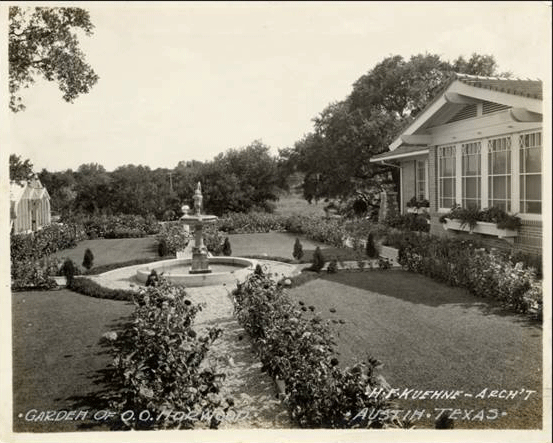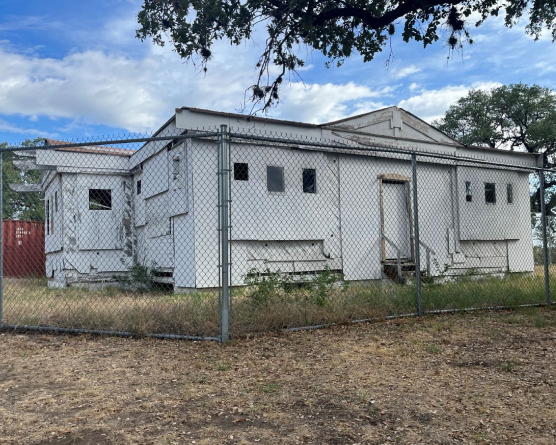The 1922 Norwood House sits on Town Lake Metropolitan Park atop a bluff on the southern side of Lady Bird Lake, west of I-35, at 1012 Edgecliff Terrace. Recently, efforts by a nonprofit partner to reconstruct the historic house and site features were halted and the Parks and Recreation Department is evaluating whether to continue with the project or propose an alternative improvement at the site. City Council District 9
Update
A memo was issued to Mayor and Council announcing the completion of a draft report about the Norwood House and site, including its history, status, contextual changes in the surrounding area, and potential options for the future as a park space and amenity. Links to the memo and associated report can be found below.
- November 22, 2024 Memo
- Norwood House and Site Draft Report (PDF, 8 MB)
- Appendices:
- Appendix A: History of the Norwood House through 1970s (PDF, 1.5 MB)
- Appendix B: History of the Norwood House through the 1980s (PDF, 4.5 MB)
- Appendix C: History of the Norwood House through the 1990s (PDF, 3 MB)
- Appendix D: History of the Norwood House through 2010 (PDF, 6 MB)
- Appendix E: The Norwood Park Conditions Assessment and Feasibility Report (PDF, 12.5 MB)
- Appendix F: The Norwood Park Foundation Agreement and Amendments (PDF, 3.5 MB)
- Appendix G: Letter of Support from South River City Citizens/Revive Norwood Alliance (PDF, 165 KB)
- Appendix A: History of the Norwood House through 1970s (PDF, 1.5 MB)

The Norwood House circa the 1920s, classic Arts & Crafts bungalow in the California Craftsman style. Photo credit: Austin History Center, Austin Public Library C01463a
In 1922, local developer Ollie O. Norwood and his wife, Calie Norwood, built a brick bungalow with distinctive battered river rock columns on the bluffs above the south bank of the Colorado River just west of the area where I-35 now crosses Lady Bird Lake. The Norwood House, attributed to prominent Austin architect Hugo Kuehne, originally occupied a 4-acre estate that included a rose garden, a greenhouse, a decorative fountain, a gazebo/teahouse, and the first geothermal-fed swimming pool in Austin.
History
- Relocation of Norwood House
-
The Norwoods sold the house and surrounding acreage in 1961, and the house was converted to office space. The conversion resulted in the removal of many original finishes. In 1982, a developer proposed to purchase the tract and develop condominiums; however, the proposal was met with resistance from local stakeholders. Negotiations ensued between multiple parties including the owner, the developer, neighborhood residents, historic preservationists, and the City of Austin. In 1984, an agreement was reached to relocate the house to an adjacent lot at 1009 Edgecliff Terrace, which was given historic zoning as a City of Austin Landmark. Unfortunately, the building’s exterior finishes were badly compromised by the 1980s relocation.
In 1985, the condo development ultimately fell through, and the City of Austin purchased the original Norwood Tract from the developer for use as a public park. However, the house now sat on privately-owned land. Neighborhood residents and historic preservationists advocated for the City of Austin to purchase the house and relocate it back to its original site. The City of Austin ultimately acquired the parcel at Edgecliff Terrace in 1986 for the widening of Riverside Drive.
- The Women's Chamber of Commerce of Texas
-
In 1989, the City Council supported an agreement giving the Women’s Chamber of Commerce of Texas five years to raise the funds to move the house back to its original site and lead a restoration effort. The Chamber planned to restore the house as a visitor’s center, a research facility for women’s economic issues, and a sculpture garden to honor the achievements of Texas women. Though it took longer than initially planned, the Women’s Chamber of Commerce successfully funded the relocation of the house from 1009 Edgecliff Terrace back to its original site in 1998. However, the restoration plans for the house were never realized. In 2000, the Women’s Chamber of Commerce withdrew further support for the project.
- 2011 Feasibility Study
-
In 2011, the Parks and Recreation Department (PARD) completed a feasibility study and community engagement process to assess the condition of the Norwood House and explore options for the overall parkland tract, which includes an adjacent off-leash dog area. During this study, the historic preservation consultant for the assessment recommended the removal of the historic landmark designation due to the loss of structural integrity. At the conclusion of the process, PARD supported an option to reconstruct the house and grounds, as there was strong community support and a nonprofit partner, the Norwood Park Foundation, eager to leverage private funding to support the project.
2011 Feasibility Study (PDF, 35 MB)
Letter from Historic Preservation Consultant (PDF, 3 MB)
2011 Community Engagement (PDF, 22.95 MB)
Supported Option (PDF, 9.3 MB)
- Norwood Park Foundation Agreement
-
In 2012, Austin City Council Resolution 20120614-022 directed the City Manager to negotiate and execute an agreement with the Norwood Park Foundation (NPF) for the Norwood House’s reconstruction, restoration of landscape features, and construction of new auxiliary buildings. The NPF was formed as a sub-committee of the South River City Citizens Neighborhood Association in 2008.
NPF’s goal was to reconstruct the building to reflect its original Arts and Crafts bungalow style and operate it as a revenue-generating event facility and community meeting space. Further council action led to a phased agreement with NPF for a Parkland Improvement Management and Operations Agreement, which was executed in 2013. The cost of construction was to be funded by the NPF using private resources, including an interest-free loan, donations, and grants. The agreement was amended in 2021 to reduce NPF’s scope of work, extend the term of the agreement, and allow public funding to partially support the project. Additionally, the amendment removed the future operations, maintenance, and management component of the agreement and focused solely on the capital project.
Despite scope reductions and attempts to phase the project, the overall cost ballooned due to pandemic-related escalations in construction and labor costs. In December 2022, NPF terminated its agreement with the City of Austin for the reconstruction of the Norwood House and associated site features. Important planning and design work was completed before NPF halted the process, including environmental remediation, foundation work, heritage tree preservation work, design development, 100% construction documents, and completed site development permits. PARD greatly appreciates the efforts put forth by NPF, which faced unprecedented construction cost escalation as well as complications and uncertainty brought forth by two massive transportation projects directly adjacent to the site; the I-35 Capital Expressway and Project Connect Light Rail.

Photo credit: Austin History Center, Austin Public Library PICH 06754a
The Norwood House Today

The building stands as a wood frame shell. It no longer retains its original brick cladding, river rock and brick columns, and terracotta tile roof, which were lost in previous relocations. The building has no viable original windows and doors. There are no interior finishes of any kind (Figures 12-15). While NPF built a new foundation, added new internal bracing and framing and provided temporary roofing, the condition of the Norwood House is poor, and the building continues to deteriorate. The Department made several emergency repairs in Fall 2023, including a full board-up of the building, the application of a preservation seal coat of paint to the entire building, and the installation of a new poly glass Modified Bitumen Membrane to the entire roof.
Additionally, the I-35 Capital Express Central project is immediately adjacent to the Norwood Tract and the area will experience intense construction for many years. The project includes the construction of a new, expanded vehicular bridge over Lady Bird Lake and a redesigned intersection at Riverside and I-35, which may greatly change the context and setting of the Norwood House. The I-35 project will result in an additional pedestrian and bike crossing from Riverside Drive across Lady Bird Lake on the west side of I-35, however, due to the Norwood site’s location atop a tall bluff, there will not be a direct connection to the Boardwalk along Lady Bird Lake. The first phase of the city’s light rail line will traverse Riverside Drive on the southern end of the property. Final decisions on station placement are expected in 2024. Following NPF’s termination of the agreement, PARD spent several months engaging other nonprofit partners to gauge interest in the project but was unsuccessful in identifying a nonprofit partner to pursue the project.
Lacking a nonprofit partner with the organizational capacity to fund and manage the project and operate a future event facility, as City Council had directed, PARD will convene a review of the project and return to City Council with its findings and a recommended course of action. Options include, but are not limited to 1) PARD identifying future funding, assuming project management, and operating the site in a similar fashion to other event rentals. This option entails an initial investment in appropriately mothballing the building as well as a potentially significant delay due to adjacent transportation projects; or 2) PARD explores an alternative improvement at the site, such as an overlook feature, that would honor and interpret the Norwood House and the countless hours of volunteer time and advocacy that have been invested in the project. This option would require planning, design, and funding to implement and would require the removal of the City of Austin Historic Landmark designation and what remains of the Norwood House.
As part of this review, PARD will directly inform community stakeholders, historic preservation advocacy groups, and other interested organizations to assist them in understanding the problem, alternatives, opportunities, and solutions. Additionally, PARD will offer briefings to the Historic Landmark Commission and the Parks and Recreation Board.
PARD recognizes and appreciates that 40 years of community and City efforts have been invested into the reconstruction of the Norwood House and grounds.
Anticipated Schedule
- Spring 2024: PARD re-assessment
- Fall 2024: PARD to engage City Council on findings and recommendations for next steps
Updates and Communications
Presentation (PDF) to the Parks and Recreation Board, September 25, 2018
A memo was issued to Mayor and Council addressing the status of the Norwood House. The memo can be read at the link below.
Contact Information
For more information, email PARD Project Manager D'Anne Williams at danne.williams@austintexas.gov or by phone at or 512-974-9456.


